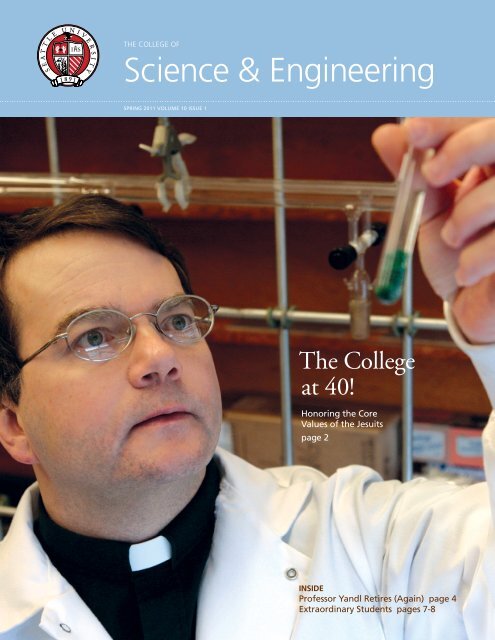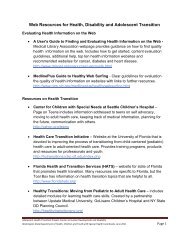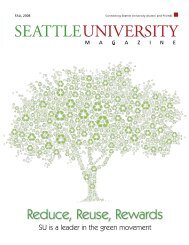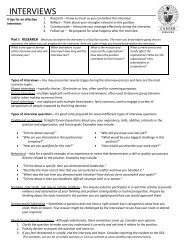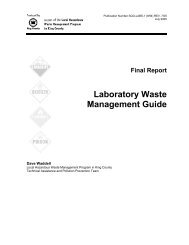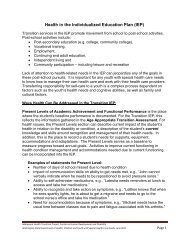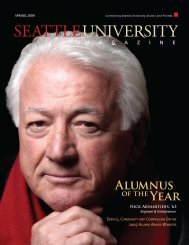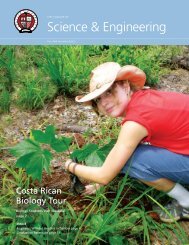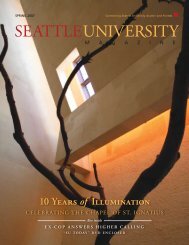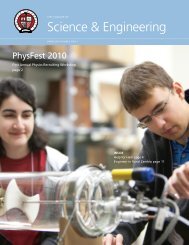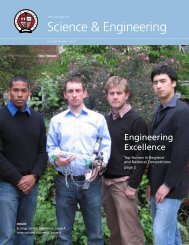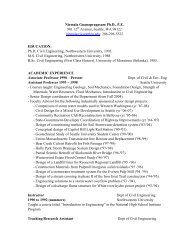the College of Science & Engineering - Seattle University
the College of Science & Engineering - Seattle University
the College of Science & Engineering - Seattle University
Create successful ePaper yourself
Turn your PDF publications into a flip-book with our unique Google optimized e-Paper software.
The <strong>College</strong> <strong>of</strong><br />
<strong>Science</strong> & <strong>Engineering</strong><br />
SPRING 2011 VOLUME 10 ISSUE 1<br />
The <strong>College</strong><br />
at 40!<br />
Honoring <strong>the</strong> Core<br />
Values <strong>of</strong> <strong>the</strong> Jesuits<br />
page 2<br />
INSIDE<br />
Pr<strong>of</strong>essor Yandl Retires (Again) page 4<br />
Extraordinary Students pages 7-8
2 <strong>Science</strong> & <strong>Engineering</strong> seattle university 3<br />
The <strong>College</strong> at 40! Honoring <strong>the</strong> Core Values<br />
message from <strong>the</strong> dean: dr. michael j. quinn<br />
Forty years ago a campus reorganization combined science, ma<strong>the</strong>matics, and engineering<br />
programs to establish what is now <strong>the</strong> <strong>College</strong> <strong>of</strong> <strong>Science</strong> and <strong>Engineering</strong>. As we celebrate this<br />
anniversary, it is appropriate to look back and consider <strong>the</strong> legacy <strong>of</strong> our “founding Fa<strong>the</strong>rs.”<br />
We owe much to <strong>the</strong> leadership and vision <strong>of</strong> <strong>the</strong> Jesuits who<br />
promoted science and engineering education on our campus.<br />
<strong>Seattle</strong> <strong>College</strong> began with a charter to <strong>of</strong>fer its students “a<br />
thorough classical and commercial education.” Fa<strong>the</strong>r Joseph<br />
Tomkin, SJ, who became President in 1914, recognized <strong>the</strong><br />
importance <strong>of</strong> science in a college education. He moved quickly<br />
to reform <strong>the</strong> undergraduate curriculum by adding science courses<br />
in lieu <strong>of</strong> classes in some <strong>of</strong> <strong>the</strong> more traditional subjects, such<br />
as Latin and Greek.<br />
Fa<strong>the</strong>r Lammert (Bert) Otten, SJ<br />
Fa<strong>the</strong>r Otten, SJ, taught in <strong>the</strong> Department <strong>of</strong> Electrical and<br />
Computer <strong>Engineering</strong> from 1983-2005. Since his retirement from<br />
<strong>Seattle</strong> <strong>University</strong>, he has taken up residence in <strong>the</strong> small African<br />
village <strong>of</strong> Chikuni, Zambia.<br />
Fa<strong>the</strong>r Eric Watson, SJ<br />
Fa<strong>the</strong>r Watson, SJ, is a chemist and is at present <strong>the</strong> only Jesuit<br />
teaching in <strong>the</strong> <strong>College</strong> <strong>of</strong> <strong>Science</strong> & <strong>Engineering</strong>. He joined <strong>the</strong><br />
faculty in <strong>the</strong> fall <strong>of</strong> 2009.<br />
Photos courtesy <strong>of</strong> Chris Joseph Taylor<br />
After World War II, Fa<strong>the</strong>r Edmund R. McNulty, SJ, <strong>the</strong> first Dean<br />
<strong>of</strong> <strong>the</strong> School <strong>of</strong> <strong>Engineering</strong>, played a leading role in creating<br />
space for <strong>the</strong> School in <strong>the</strong> renovated Madison Street Cable Car<br />
Barn (now <strong>the</strong> Fine Arts Building). He also used his contacts with<br />
<strong>the</strong> military to acquire war surplus equipment for <strong>the</strong> electrical<br />
and mechanical laboratory.<br />
Two Jesuit electrical engineering pr<strong>of</strong>essors have played a particularly<br />
influential role in our <strong>College</strong>’s history. In <strong>the</strong> early 1960s,<br />
Fa<strong>the</strong>r Frank Wood, SJ, established a tradition—which continues<br />
to this day—<strong>of</strong> sending some <strong>of</strong> our best engineering graduates<br />
to doctoral studies at Stanford <strong>University</strong>. He also spearheaded<br />
<strong>the</strong> establishment <strong>of</strong> <strong>the</strong> Master <strong>of</strong> S<strong>of</strong>tware <strong>Engineering</strong> program<br />
in 1979, which granted <strong>the</strong> nation’s first MSE degree in 1982.<br />
At <strong>the</strong> beginning <strong>of</strong> <strong>the</strong> new century, Fa<strong>the</strong>r Bert Otten’s trips to<br />
Africa demonstrated to <strong>the</strong> rest <strong>of</strong> <strong>the</strong> <strong>College</strong> how engineers<br />
can actualize <strong>the</strong> preferential option for <strong>the</strong> poor, a key social<br />
teaching <strong>of</strong> <strong>the</strong> Catholic Church. Dozens <strong>of</strong> students, faculty,<br />
and staff at <strong>Seattle</strong> <strong>University</strong> are now following his lead. Our<br />
student chapter <strong>of</strong> Engineers Without Borders and <strong>the</strong> staff-led<br />
Pr<strong>of</strong>essionals Without Boundaries groups continue projects in<br />
Haiti, Jamaica, Nicaragua, Thailand, and Zambia.<br />
In some respects our <strong>College</strong> has changed immensely in <strong>the</strong> past<br />
forty years. We have new majors like environmental science,<br />
and personal computers are ubiquitous. Dozens <strong>of</strong> our students<br />
stay on campus every summer to perform research under <strong>the</strong><br />
mentorship <strong>of</strong> faculty members. Many students study abroad or<br />
complete a service-learning experience in a developing country.<br />
Our fundamental mission, however, has not changed. You may<br />
find but a single Jesuit in <strong>the</strong> <strong>College</strong>, but you will still see <strong>the</strong><br />
legacy <strong>of</strong> <strong>the</strong> Jesuits in <strong>the</strong> way our faculty and staff collectively<br />
uphold <strong>the</strong> core values <strong>of</strong> care for each person, an insistence<br />
upon academic excellence, a commitment to educating <strong>the</strong> disadvantaged,<br />
and a belief that we should measure our success by<br />
<strong>the</strong> success <strong>of</strong> our students. ■<br />
Fa<strong>the</strong>r Edmund R. McNulty, SJ<br />
1907-1982<br />
Fa<strong>the</strong>r McNulty, SJ, served as Dean <strong>of</strong> <strong>the</strong> newly-formed School <strong>of</strong><br />
<strong>Engineering</strong> from 1942 to 1956. The 1953 Aegis yearbook was<br />
dedicated to him, giving tribute “to one whose selflessness and<br />
perseverance have been most instrumental in building a greater<br />
<strong>Seattle</strong> <strong>University</strong> for a greater <strong>Seattle</strong>.”<br />
Photo courtesy <strong>of</strong> Lemieux Library Special Collections<br />
Fa<strong>the</strong>r Francis P. Wood, SJ<br />
1917-1992<br />
Fa<strong>the</strong>r Wood, SJ, served as chair <strong>of</strong> <strong>the</strong> Department <strong>of</strong> Electrical<br />
<strong>Engineering</strong> for 25 years, from 1959 to 1984. He was notable for<br />
taking summer jobs in industry, first with <strong>the</strong> Bonneville Power<br />
Administration, and <strong>the</strong>n with The Boeing Company, where he did<br />
work in control systems for jet airliners. He was known for his rigor<br />
in <strong>the</strong> classroom, and was both feared and revered by many students.<br />
Photo courtesy <strong>of</strong> Lemieux Library Special Collections<br />
Photo courtesy <strong>of</strong> Lemieux Library Special Collections<br />
“The six-week trip I took to Zambia in 1998 had a big effect on<br />
me. I saw <strong>the</strong> many projects Fr. Otten had undertaken—from<br />
solar panels to dams to water purification—and <strong>the</strong> improvement<br />
<strong>the</strong>se projects brought to <strong>the</strong> local people. I was so inspired<br />
by this trip that I ended up leaving an engineering career after<br />
three years to join <strong>the</strong> Peace Corps. I wanted to use my education<br />
to help those in need as we had done in Zambia. After returning<br />
from <strong>the</strong> Peace Corps I continued to correspond with Fr. Otten,<br />
and we met up each year when he returned to <strong>the</strong> United States.<br />
We exchanged ideas, particularly on battery-powered LED lights,<br />
and I was again inspired by his work in this area. This led me to<br />
develop a website (buildabetterlight.org) detailing construction<br />
techniques for LED lights suitable for people living <strong>of</strong>f-grid in<br />
developing countries. Fr. Otten’s ingenuity, his generosity, and his<br />
dedication to service had a pr<strong>of</strong>ound impact on my direction in<br />
life, and for that I’m forever grateful to him.”<br />
Jared Ellerbrock ’98, ‘05<br />
President Albert Lemieux, SJ, and Thomas Bannan inspect a model <strong>of</strong> <strong>the</strong><br />
new science building in 1961.<br />
“I had Fr. Watson as a pr<strong>of</strong>essor for my third quarter <strong>of</strong> general<br />
chemistry. I went to public school my whole life until arriving at<br />
<strong>Seattle</strong> U, so I assumed I would have some Jesuits as pr<strong>of</strong>essors.<br />
I didn’t realize how rare having a Jesuit in <strong>the</strong> <strong>College</strong> <strong>of</strong> <strong>Science</strong><br />
and <strong>Engineering</strong> was until I told my family and <strong>the</strong>y were blown<br />
away. My bro<strong>the</strong>r didn’t think that priests or Jesuits were pr<strong>of</strong>essional<br />
scientists assuming that it would present a conflict <strong>of</strong><br />
interest for <strong>the</strong>m. Once my family had pointed out <strong>the</strong> rarity <strong>of</strong><br />
being taught chemistry by a Jesuit, I started to think about it<br />
more. Not only do I admire Fr. Watson’s intelligence, but I think<br />
I share a similar view <strong>of</strong> <strong>the</strong> relationship, not conflict, between<br />
science and my religion.<br />
General chemistry presented me with a constant challenge <strong>of</strong><br />
staying interested and following a sometimes dry lecture. When<br />
I got to third quarter, I was refreshed with Fr. Watson’s witty<br />
comments and ability to poke fun at chemistry. It felt like he<br />
came down to our level. It was a nice change, and I was able to<br />
get more out <strong>of</strong> lecture because he kept my attention better.<br />
I am now in organic chemistry, so I don’t have <strong>the</strong> opportunity<br />
to see Fr. Watson in <strong>the</strong> classroom this year. I do get to run into<br />
him frequently at <strong>the</strong> 9 p.m. mass on Sunday nights, though. He<br />
always asks how my classes are going and how I’m doing. I feel<br />
fortunate to have pr<strong>of</strong>essors like him remember me and continue<br />
a relationship even if I’m no longer in <strong>the</strong>ir classes; it reminds me<br />
how special <strong>Seattle</strong> <strong>University</strong> is and how glad I am that I made<br />
<strong>the</strong> decision to attend.”<br />
Emily Becker<br />
We remember… Gerald Beezer, SJ Ernest Bertin, SJ James Cowgill, SJ Leo Gaffney, SJ <br />
Eugene Healy, SJ John Koehler, SJ Paul Luger, SJ Clair Marshall, SJ Leo Schmid, SJ
4 <strong>Science</strong> & <strong>Engineering</strong> seattle university 5<br />
A Legacy <strong>of</strong> Caring: Pr<strong>of</strong>essor Andre Yandl<br />
In early 1956, newly-minted master’s degree recipient Andre Yandl waited anxiously to hear<br />
from <strong>Seattle</strong> <strong>University</strong>’s Ma<strong>the</strong>matics Department regarding an unadvertised position. He was<br />
thrilled to find that he was successful, along with his colleague C.C. Chang. They taught in<br />
leaky Quonset huts on <strong>the</strong> site <strong>of</strong> <strong>the</strong> current St. Iganatius Chapel — a far cry from <strong>the</strong> beautiful<br />
campus we see today!<br />
Andre Yandl joined <strong>the</strong> <strong>Seattle</strong><br />
<strong>University</strong> Ma<strong>the</strong>matics<br />
Department in 1956, bringing<br />
<strong>the</strong> number in <strong>the</strong> department<br />
to four.<br />
Yandl was born in Algiers. During<br />
World War II, a British soldier, Dick<br />
Bird, taught him to play ping pong<br />
on “a lark.” Bird was one <strong>of</strong> <strong>the</strong><br />
best players in England and an able<br />
teacher. In a few months, Yandl<br />
mastered <strong>the</strong> game and helped to<br />
beat “<strong>the</strong> Yanks” in an historic<br />
match. His passion for <strong>the</strong> sport<br />
never diminished, later bringing<br />
him a campus title against stiff<br />
competition from Chinese students.<br />
He trained <strong>the</strong> Saudi Arabian team<br />
in 1976 and accompanied <strong>the</strong>m to<br />
<strong>the</strong> Montreal Olympics.<br />
After <strong>the</strong> war, Yandl immigrated to Wenatchee and enrolled in<br />
high school. A French speaker, he attended classes taught in<br />
English in hopes that something would “click.” An observant<br />
teacher recognized his exceptional aptitude for ma<strong>the</strong>matics<br />
and introduced him to teachers who encouraged him in science<br />
and ma<strong>the</strong>matics. His academic success led him to <strong>the</strong> <strong>University</strong><br />
<strong>of</strong> Washington for undergraduate and graduate degrees in<br />
ma<strong>the</strong>matics. Except for a year spent at Western Washington<br />
<strong>University</strong>, Yandl has spent his entire teaching career at <strong>Seattle</strong><br />
<strong>University</strong>.<br />
In 1969, Yandl was named a full pr<strong>of</strong>essor. He has received<br />
numerous awards including ASSU’s first Outstanding Teacher<br />
award and <strong>the</strong> Excellence in Teaching award. He annually hosted<br />
<strong>the</strong> Math Club in his home for dinner and served as chair <strong>of</strong> <strong>the</strong><br />
Ma<strong>the</strong>matics Department from 1966-1979. He has published<br />
seven textbooks and countless articles and pamphlets. Throughout<br />
<strong>the</strong> years he has taken leadership positions in a multitude <strong>of</strong><br />
pr<strong>of</strong>essional organizations.<br />
The greatest legacy he leaves <strong>Seattle</strong> U<br />
lies in his availability to students. He has<br />
spent countless hours sitting over c<strong>of</strong>fee<br />
in <strong>the</strong> Collegia, working with students in<br />
<strong>the</strong>ir own environment.<br />
Pr<strong>of</strong>essor Emeritus Andre Yandl greets one and all in his <strong>of</strong>fice with his<br />
traditional warmth.<br />
In 2001, at <strong>the</strong> age <strong>of</strong> 70, Andre Yandl retired — for <strong>the</strong> first<br />
time. He was granted <strong>the</strong> title <strong>of</strong> pr<strong>of</strong>essor emeritus but continued<br />
to teach. Now, in 2011, as he approaches his 80th birthday, he will<br />
retire again. It is difficult to believe that he will ever slow down.<br />
What is Pr<strong>of</strong>essor Yandl’s legacy after 45 years at <strong>Seattle</strong> U? He has<br />
attained an international reputation for excellence in ma<strong>the</strong>matics<br />
education. He is known among his peers for his collegiality and<br />
dedicated service. But <strong>the</strong> greatest legacy he leaves <strong>Seattle</strong> U lies<br />
in his availability to students. He has spent countless hours sitting<br />
over c<strong>of</strong>fee in <strong>the</strong> Collegia, working with students in <strong>the</strong>ir own<br />
environment. He loves his subject but, even more, he loves each<br />
student who sits in his class. What has made him extraordinary is<br />
his selflessness and joyous generosity <strong>of</strong> spirit. As he is wont to<br />
say to undergrads, “The teacher is <strong>the</strong> doctor. You don’t go to see<br />
<strong>the</strong> doctor when you are about to die. You go when you are<br />
sick.” And this doctor is always in.<br />
We <strong>of</strong>fer our heartfelt appreciation to this exemplary pr<strong>of</strong>essor for<br />
his long and loyal service to <strong>the</strong> students <strong>of</strong> <strong>Seattle</strong> <strong>University</strong>. ■<br />
Campus “Boeing Day” Spotlights Ethics<br />
On January 20th, <strong>Seattle</strong> <strong>University</strong> celebrated “Boeing Day” on<br />
campus. Boeing recruiters were available to speak with students<br />
about employment and internship opportunities with <strong>the</strong> company.<br />
In keeping with a <strong>the</strong>me <strong>of</strong> ethics and accountability, <strong>the</strong> <strong>College</strong><br />
<strong>of</strong> <strong>Science</strong> & <strong>Engineering</strong> welcomed Advisory Board member<br />
Deborah Limb ’88, Director <strong>of</strong> Payloads & Structures <strong>Engineering</strong><br />
at The Boeing Company, to campus to lead a panel discussion<br />
entitled “Accountability and Me” for students and faculty. Her<br />
powerful presentation explored issues surrounding ethical<br />
decision-making in <strong>the</strong> business environment and how core values<br />
shape <strong>the</strong> pr<strong>of</strong>essionals <strong>of</strong> <strong>the</strong> future. Ms. Limb cited specific<br />
examples <strong>of</strong> situations where she was challenged to make significant<br />
decisions for Boeing and told <strong>of</strong> how grateful she was to<br />
have been deeply rooted in <strong>the</strong> ethical discernment she learned<br />
as a student at <strong>Seattle</strong> <strong>University</strong> and through Fr. Robert Spitzer,<br />
SJ. She also spoke about how grateful she was to work for a<br />
company that was deeply committed to fostering ethical<br />
practices and personal accountability in all dealings, internally<br />
and externally. The audience was captivated by her candor and<br />
enthusiasm.<br />
Ms. Limb’s presentation was followed by a panel discussion.<br />
Joining her were fellow Advisory Board member Carolyn<br />
Brandsema, Vice President <strong>of</strong> Airplane & Production Systems at<br />
Boeing Commercial Airplanes, and Michael Delaney, Vice President<br />
<strong>of</strong> <strong>Engineering</strong> for Boeing Commercial Airplanes. The panel<br />
was ably chaired by J.J. Iwasaki ’89, Ethics Officer for The<br />
Boeing Company.<br />
On February 11, <strong>the</strong> <strong>College</strong>’s undergraduate<br />
research program was<br />
highlighted at <strong>the</strong> Board <strong>of</strong> Regents<br />
meeting when faculty and students<br />
talked about <strong>the</strong>ir research.<br />
Dr. Doug Latch and student John<br />
Berude generated a lot <strong>of</strong> questions<br />
from <strong>the</strong> Regents after <strong>the</strong>y spoke<br />
about pollution to <strong>the</strong> Duwamish River<br />
caused by chemicals being washed<br />
into storm sewers.<br />
Dr. Joanne Hughes-Clark and student<br />
Andrew Hankins discussed research<br />
into identifying “dark matter” galaxies<br />
near <strong>the</strong> Milky Way. The audience<br />
members were intrigued to hear that<br />
highly sophisticated telescopes can be controlled by laptop<br />
computers via <strong>the</strong> Internet.<br />
An engaged audience listens intently to Boeing executive and <strong>College</strong> Advisory<br />
Board member, Deborah Limb ’88, as she speaks about <strong>the</strong> everyday<br />
challenges in making ethical decisions. Boeing Executives Mike Delaney<br />
and Carolyn Brandsema joined her in a panel discussion (front row).<br />
Photo courtesy <strong>of</strong> Lindsey Wasson<br />
The panel discussion was followed by a presentation by Jim<br />
Albaugh, CEO <strong>of</strong> Boeing Commercial Airplanes, at <strong>the</strong> Albers<br />
School <strong>of</strong> Business and Economics. An audience <strong>of</strong> 400 heard<br />
Albaugh’s thought-provoking presentation, “There Are No Shortcuts:<br />
Reflections on Leadership, Ethics, and Innovation.” Following<br />
<strong>the</strong> presentation, a reception for Boeing SU alumni was held in<br />
<strong>the</strong> Boeing Room <strong>of</strong> <strong>the</strong> Library and Learning Commons. ■<br />
Undergraduate Research Highlights Board <strong>of</strong> Regents<br />
Sophomore Caitlyn<br />
Echterling discusses <strong>the</strong><br />
effects <strong>of</strong> floods on river<br />
channels at <strong>the</strong> Board <strong>of</strong><br />
Regents meeting in<br />
February. Photo courtesy<br />
<strong>of</strong> Heath Braun<br />
Dr. Wes Lauer and student Caitlyn Echterling are investigating<br />
how river channels change over time. They described a model <strong>the</strong>y<br />
are developing to estimate <strong>the</strong> amount <strong>of</strong> sediment contributed<br />
by each tributary <strong>of</strong> a river system. The Regents were impressed<br />
to learn that Caitlyn, Andrew, and John are already involved in<br />
research projects, even though <strong>the</strong>y are only sophomores.<br />
After <strong>the</strong> pr<strong>of</strong>essors and students spoke, Dean Quinn addressed<br />
<strong>the</strong> Board <strong>of</strong> Regents. He discussed <strong>the</strong> rapid growth in undergraduate<br />
student research within <strong>the</strong> <strong>College</strong> <strong>of</strong> <strong>Science</strong> and<br />
<strong>Engineering</strong> over <strong>the</strong> past few years, thanks to a generous grant<br />
from <strong>the</strong> M.J. Murdock Charitable Trust. The summer research<br />
program is a great opportunity for students to get a summer job<br />
related to <strong>the</strong>ir career goals. Students who participate in research<br />
get <strong>the</strong> opportunity to deepen <strong>the</strong>ir knowledge, develop<br />
expertise working with sophisticated scientific instruments, and<br />
in many cases help write scientific papers. All <strong>of</strong> <strong>the</strong>se experiences<br />
can improve a student’s prospects, whe<strong>the</strong>r that student’s<br />
goal is to attend graduate school, go to medical school, or find<br />
employment. ■
6 <strong>Science</strong> & <strong>Engineering</strong> seattle university 7<br />
Bannan Scholar Pr<strong>of</strong>ile: Aziz Yuldashev<br />
Yes, I once was a shepherd in a small town with no electricity.<br />
Yes, I go to <strong>Seattle</strong> <strong>University</strong>.<br />
And heck yes, I’m going to design microchips!<br />
My name is Aziz Yuldashev. I was born and raised in Uzbekistan,<br />
one <strong>of</strong> Soviet Republics until 1991. My childhood was spent in<br />
<strong>the</strong> mountains. I was raised in a lower middle-class family in<br />
provincial Jizzakh. My mom and dad were born and raised in<br />
Kazakhstan, went to college in Uzbekistan where <strong>the</strong> government<br />
assigned <strong>the</strong>m to work. When <strong>the</strong> Soviet Union collapsed, <strong>the</strong>y<br />
were forced to become Uzbek citizens and became separated<br />
from <strong>the</strong>ir families in Kazakhstan. I have three sisters much older<br />
than I.<br />
I did not have a playful childhood. The hardship caused by <strong>the</strong><br />
totalitarian Uzbek government made it very hard for people to<br />
make a living. In this political situation, children do physical labor.<br />
My dad explained to me how hard it was to support <strong>the</strong> family,<br />
and told me that I needed to help. I was nine years old when my<br />
fa<strong>the</strong>r arranged for me to be a shepherd with a family friend in<br />
<strong>the</strong> nearby village for five summers.<br />
Although sustaining a large herd <strong>of</strong> livestock was a great<br />
achievement and <strong>the</strong> experience was truly unforgettable, being<br />
a shepherd was not what I wanted to do. I was always interested<br />
in math, science, and foreign languages. So when I was fourteen,<br />
I signed up for English lessons in a school run by <strong>the</strong> Peace Corps<br />
where volunteers taught me English and helped me apply for<br />
<strong>the</strong> U.S. State Department’s education exchange FLEX program<br />
(Future Leaders Exchange). Getting into this competitive program<br />
changed <strong>the</strong> trajectory <strong>of</strong> my life. I came to <strong>the</strong> U.S. as an<br />
exchange student and lived with a wonderful family in <strong>Seattle</strong>.<br />
With financial help from my host family, I attended North <strong>Seattle</strong><br />
Community <strong>College</strong>, graduating with an Associate <strong>of</strong> <strong>Science</strong><br />
Degree in June 2009. Though I received a great <strong>of</strong>fer from<br />
Columbia <strong>University</strong> and many o<strong>the</strong>r schools throughout <strong>the</strong><br />
country, my decision to transfer to <strong>Seattle</strong> <strong>University</strong> was made<br />
<strong>the</strong> day I opened <strong>the</strong> letter <strong>of</strong> acceptance. I feel accepted,<br />
understood and at home at <strong>Seattle</strong> U. I am enrolled full-time,<br />
studying electrical and computer engineering.<br />
Becoming a Bannan Scholar means <strong>the</strong> world to me. Not only<br />
does <strong>the</strong> Bannan Scholarship ease my financial constraints, it<br />
also <strong>of</strong>fers a great opportunity to do community service, be<br />
The Bannan Scholarship allows me to<br />
find mentors in <strong>the</strong> fields <strong>of</strong> science and<br />
engineering, and to do my part as a<br />
mentor for younger students.<br />
Bannan Scholar Aziz Yuldashev <strong>of</strong> Uzbekistan will graduate from <strong>Seattle</strong><br />
<strong>University</strong> in June with a degree in Electrical <strong>Engineering</strong>. Photo courtesy<br />
<strong>of</strong> Hilary Northcraft<br />
engaged in <strong>the</strong> science and engineering community, and meet<br />
leading researchers at new innovative companies. These researchers<br />
develop modern and advanced technologies that are<br />
pertinent to my interests and future career. I can fur<strong>the</strong>r explore<br />
both with undergraduate research and summer internships. The<br />
Bannan Scholarship also allows me to find mentors in <strong>the</strong> fields<br />
<strong>of</strong> science and engineering, and to do my part as a mentor for<br />
younger students. As a Bannan Scholar, I am encouraged to be<br />
more involved on campus and in <strong>the</strong> local community. The Bannan<br />
Scholarship proved to me that science and engineering students<br />
don’t sit in <strong>the</strong> lab all day and work on <strong>the</strong>ir crazy projects!<br />
I am an engineer and I have a great desire to help o<strong>the</strong>rs and to<br />
“be involved”. This year I became Vice Chair <strong>of</strong> <strong>Seattle</strong> <strong>University</strong>’s<br />
IEEE (Institute for Electrical and Electronics Engineers) chapter<br />
and a Resident Assistant (RA) in Xavier Global House. After<br />
graduation, my plan is to continue my studies at a graduate<br />
school. Currently, I am interested in <strong>the</strong> ongoing research <strong>of</strong> cost<br />
and energy efficient semiconductor devices, which are <strong>the</strong><br />
building blocks <strong>of</strong> logic and memory microchips.<br />
Thanks to <strong>the</strong> Bannan Scholarship I have grown as a person, in<br />
addition to my academic success, so thank you donors! ■<br />
Senior Lindsay Stetson prepares for a seminar as she readies herself for <strong>the</strong> next step in her career – doctoral studies at <strong>the</strong> <strong>University</strong> <strong>of</strong> Pennsylvania.<br />
Photo courtesy <strong>of</strong> Chris Joseph Taylor<br />
Carrying a <strong>Seattle</strong> <strong>University</strong> Legacy into <strong>the</strong> Future<br />
My name is Lindsay Stetson. Three days after my last final exam at<br />
<strong>Seattle</strong> <strong>University</strong>, I will begin doctoral studies as an NSF Graduate<br />
Research Fellow at <strong>the</strong> <strong>University</strong> <strong>of</strong> Pennsylvania. As a Ph.D.<br />
student in Genomics and Computational Biology, my goal is to<br />
develop computational tools to improve biological research. I am<br />
grateful to <strong>Seattle</strong> <strong>University</strong> for small classes, personal attention,<br />
outstanding teaching/mentorship, and research and travel<br />
opportunities that prepared me for <strong>the</strong> next phase <strong>of</strong> my career.<br />
I began my computer science/s<strong>of</strong>tware engineering research<br />
with Dr. Roshanak Roshandel in <strong>the</strong> summer <strong>of</strong> 2009 in an NSFsupported<br />
project exploring approaches where architecturebased<br />
dependability models and analysis results can be reused<br />
among related products. Generous travel awards from <strong>the</strong> <strong>College</strong><br />
<strong>of</strong> <strong>Science</strong> & <strong>Engineering</strong>, NASA, and SU’s Research Committee<br />
enabled me to present portions <strong>of</strong> this work at three academic<br />
conferences. These experiences, coupled with research collaborations<br />
with NASA’s Jet Propulsion Laboratory and two research<br />
universities, are unusual for undergraduates, setting me apart<br />
from o<strong>the</strong>r Ph.D. applicants.<br />
The unparalleled support <strong>of</strong> <strong>Seattle</strong> U faculty helped me create<br />
in-depth academic experiences that have prepared me for future<br />
tasks at <strong>the</strong> <strong>University</strong> <strong>of</strong> Pennsylvania. With encouragement<br />
from faculty mentors, I was awarded an NSF Research Experience<br />
position in computational biology at <strong>the</strong> <strong>University</strong> <strong>of</strong> Wisconsin-<br />
Madison, where I compared <strong>the</strong> efficacy <strong>of</strong> different treatments<br />
for nasopharyngeal carcinoma. This year my work focused on a<br />
capstone project with real-world relevance. As part <strong>of</strong> a team <strong>of</strong><br />
student s<strong>of</strong>tware engineers, I am designing and implementing a<br />
mobile s<strong>of</strong>tware solution that facilitates <strong>the</strong> sharing <strong>of</strong> digital<br />
ultrasound images. This project gave me <strong>the</strong> opportunity to lead<br />
a team, meet <strong>the</strong> expectations <strong>of</strong> business clients, and develop<br />
a product to be deployed by industry.<br />
Many opportunities at SU would have been out <strong>of</strong> reach at a<br />
larger institution. The emphasis on community involvement and<br />
leadership encouraged my involvement with organizations<br />
promoting women in <strong>the</strong> technical sciences—an area where<br />
women are traditionally under-represented. In March I again copresented<br />
a computing workshop at <strong>the</strong> <strong>Seattle</strong> Expanding Your<br />
Horizons (SEYH) conference, nurturing enthusiasm for science<br />
and ma<strong>the</strong>matics in middle-school girls. I am pleased that <strong>the</strong><br />
college consistently supports women in <strong>the</strong> engineering disciplines<br />
through <strong>the</strong> Society <strong>of</strong> Women Engineers and Women<br />
in Computing.<br />
<strong>Seattle</strong> <strong>University</strong> faculty members were instrumental in encouraging<br />
me to pursue a career in academia and helping me create<br />
clear, compelling, and concise essays for my Ph.D. and fellowship<br />
applications. I am grateful to my advisor, Dr. Roshandel, as well<br />
as Dr. Dingle and Dr. Kuder, Dr. Arabshahi at <strong>the</strong> <strong>University</strong> <strong>of</strong><br />
Washington, and Dr. van der Hoek at <strong>University</strong> <strong>of</strong> California Irvine.<br />
The opportunities that I have enjoyed as a <strong>Seattle</strong> U student will<br />
ensure my success at <strong>the</strong> <strong>University</strong> <strong>of</strong> Pennsylvania and will<br />
certainly benefit future generations <strong>of</strong> students. ■<br />
Years ago Lindsay Stetson left college to become primary caregiver<br />
for a grandmo<strong>the</strong>r with Alzheimer’s disease. While exploring<br />
treatments, she became interested in computational neuroscience,<br />
bringing this interest to SU. As a first generation college student,<br />
she generously mentors o<strong>the</strong>rs. “I aspire, personally and pr<strong>of</strong>essionally,<br />
to combine my academic and research experiences with<br />
outreach that assists women in discovering opportunities within<br />
<strong>the</strong> field <strong>of</strong> computing….The field <strong>of</strong> computer science, present<br />
and future, will be more robust when young women strongly<br />
associate computing with fields in which <strong>the</strong>y demonstrate<br />
interest, including <strong>the</strong> health sciences and human services,<br />
domains that increasingly benefit from advances in computing.”
8 <strong>Science</strong> & <strong>Engineering</strong> seattle university 9<br />
Student Global Engagement<br />
Fighting Cholera in Haiti<br />
Vance Warren (BSCE ’03) was working with Medical Teams<br />
International and preparing to travel to Haiti in areas devastated<br />
by cholera. He contacted Phil Thompson, chair <strong>of</strong> <strong>the</strong> Civil &<br />
Environmental <strong>Engineering</strong> Department, to get some advice on<br />
obtaining fresh water. After reviewing <strong>the</strong> basics <strong>of</strong> solar disinfection<br />
and chlorine dosing with Warren, Thompson suggested<br />
that he look for clinics needing access to safe water. Within four<br />
days, Warren had met Dr. Jhonny Fequiere, Director <strong>of</strong> <strong>the</strong> Claire<br />
Heureuse Clinic, near <strong>the</strong> heart <strong>of</strong> <strong>the</strong> outbreak, who hoped to<br />
establish that clinic as a source <strong>of</strong> safe water for local residents.<br />
In October 2010, Rotary member Tara Dacus heard Dr. Thompson<br />
speak at a Rotary function in Bellevue, Washington and was<br />
motivated to join efforts to provide Haitian medical clinics with<br />
access to safe water. A Rotary Club from Fairfield, California<br />
donated funding for fabrication <strong>of</strong> <strong>the</strong> water treatment system for<br />
<strong>the</strong> Claire Heureuse Clinic. <strong>Seattle</strong> <strong>University</strong> students assembled<br />
<strong>the</strong> water treatment system and shipped it to Haiti two days<br />
after Christmas.<br />
With <strong>the</strong> help <strong>of</strong> <strong>Seattle</strong>-based medical teams, Thompson is<br />
developing a list <strong>of</strong> clinics in Haiti requiring safe water. His goal<br />
is to install 12 <strong>of</strong> <strong>the</strong>se systems in 2011. Each <strong>of</strong> <strong>the</strong> $6,500<br />
systems can be locally maintained and includes two years’ worth<br />
<strong>of</strong> replacement supplies.<br />
On April 9th, Thompson welcomed 21 members <strong>of</strong> <strong>the</strong> Meredith<br />
Ma<strong>the</strong>ws East Madison YMCA Black Achievers to campus to<br />
learn about <strong>the</strong> water treatment system. Students spent <strong>the</strong><br />
morning learning about <strong>the</strong> engineering processes behind water<br />
treatment, and in <strong>the</strong> afternoon <strong>the</strong>y assembled three more systems<br />
for shipment to medical clinics in Haiti. Two <strong>of</strong> <strong>the</strong> treatment<br />
systems were donated by <strong>Seattle</strong>’s Emerald City Rotary Club. ■<br />
Civil engineering major Mark Beggs and Pr<strong>of</strong>essionals Without Boundaries<br />
leader Steve Szablya assess progress on <strong>the</strong> trench local families are digging<br />
with <strong>the</strong> help <strong>of</strong> <strong>the</strong> <strong>Seattle</strong> <strong>University</strong> team. The team installed a new main<br />
water line for <strong>the</strong> village <strong>of</strong> San Juan de Conception in Nicaragua.<br />
Civil <strong>Engineering</strong> major Katie Nolan checks a recycled pickle barrel used to<br />
ship <strong>the</strong> disaster relief water systems. The recycled containers serve a dual<br />
purpose; after <strong>the</strong>y are unpacked, <strong>the</strong>y will be used for critically needed<br />
water storage in Haiti.<br />
The Gift <strong>of</strong> Water in Nicaragua<br />
Imagine living where water was available only five days per<br />
week and, if more was needed, a one mile walk was required to<br />
fetch it. After four years <strong>of</strong> planning a new water line, <strong>the</strong> leaders<br />
<strong>of</strong> <strong>the</strong> village <strong>of</strong> San Juan de Concepcion, Nicaragua, were<br />
thrilled to greet a <strong>Seattle</strong> <strong>University</strong> team last December. Local<br />
engineer Raduan Dipp joined Steve Szablya, John Schrader and<br />
Johnny Llamas from Pr<strong>of</strong>essionals Without Boundaries, students<br />
Mark Beggs, Katie Rawson, and Renee Vandermause from <strong>the</strong><br />
student chapter <strong>of</strong> Engineers Without Borders, and Albers MBA<br />
alumna Letitia Goodjoint.<br />
Each <strong>of</strong> <strong>the</strong> 350 families in <strong>the</strong> village agreed to dig four meters <strong>of</strong><br />
<strong>the</strong> 1,600-meter-long trench for <strong>the</strong> new pipe. The <strong>Seattle</strong> <strong>University</strong><br />
team helped install <strong>the</strong> PVC pipe <strong>the</strong> connected <strong>the</strong> well to <strong>the</strong><br />
homes <strong>of</strong> nearly 1,500 residents. “As we worked, people would<br />
stop us on <strong>the</strong> road to thank us and said it was a great early<br />
Christmas present. I will always remember this experience…,” said<br />
Beggs. Project sponsors included Starbucks, <strong>the</strong> <strong>College</strong> <strong>of</strong> <strong>Science</strong><br />
& <strong>Engineering</strong>, and <strong>the</strong> Clean Water Foundation. ■<br />
Providing homes for <strong>the</strong> poor in Mexico<br />
In December 2010, SU Civil <strong>Engineering</strong> students Sergio Legon-<br />
Talamoni, Chris Kemly, Amanda Connell, James Smith, Omar<br />
Ongoco, Brynn Watanabe and John Conway accompanied<br />
Campus Ministry students on <strong>the</strong> 16th annual Mexico Mission<br />
Trek to Tijuana. Joining efforts with non-pr<strong>of</strong>it organization,<br />
Esperanza, <strong>the</strong> 16 students and 3 staff members laid <strong>the</strong> foundation<br />
<strong>of</strong> a home for a struggling family. The students witnessed<br />
extreme poverty and “staggering environmental degradation,”<br />
as student James Smith wrote. These issues did not preclude<br />
new friendships, bridging socio-economic and cultural barriers<br />
in <strong>the</strong> true “mission spirit” <strong>of</strong> SU. ■<br />
Clockwise from top left: Stephanie Cao (Biology), Nicole Suleiman (Biology),<br />
Shannon Nakamine (General <strong>Science</strong>), Derrik Hanson (Physics & Math),<br />
Carlo Itchon (Mechanical <strong>Engineering</strong>), Justin Willis (General <strong>Science</strong>),<br />
Elizabeth Hirshberg (Biology), Cara Southworth (Chemistry).<br />
Student Scrapbook<br />
Chemistry Club<br />
On January 27th <strong>the</strong> Chemistry Club hosted a series <strong>of</strong> “Do-it-Yourself”<br />
experiments. Here students view results <strong>of</strong> <strong>the</strong> same chemical reaction<br />
mechanism used in fireworks—in this case potassium chlorate and<br />
Gummy Bears! Students were also invited to view a demonstration <strong>of</strong><br />
making liquid nitrogen ice cream. Club Co-President Sonam Ghag<br />
reported that over 35 students participated in <strong>the</strong> festivities, proving<br />
that science can entertain as well as instruct.<br />
Photo courtesy <strong>of</strong> Sonam Ghag<br />
Future Cities<br />
Seniors Wayne Urubio and Vinh Ho watch while a student tries out<br />
<strong>the</strong> human-powered generator at <strong>the</strong> Future Cities Competition on<br />
January 22. The <strong>Seattle</strong> Center event, attracted middle school<br />
students from across <strong>the</strong> state. The goal <strong>of</strong> Urubio, Ho, and <strong>the</strong>ir<br />
senior design project teammates, Yousef Alganna and Steven Cruz, was<br />
to design 100 watt generators that can be used in rural communities<br />
without access to <strong>the</strong> electricity grid. These generators can be used to<br />
charge batteries for lamps, radios, and cellular phones. Their faculty<br />
advisor, Henry Louie, gave <strong>the</strong> keynote speech entitled “<strong>Engineering</strong><br />
a Future City,” which describes <strong>the</strong> role engineers will play in making<br />
tomorrow’s cities a reality.<br />
Peer Mentor Program<br />
This year, <strong>the</strong> <strong>Science</strong> & <strong>Engineering</strong> Peer Mentor Program expanded<br />
to serve new students from all majors in <strong>the</strong> <strong>College</strong>. Over 60 new<br />
first-year and transfer students signed up to work with a junior or<br />
senior peer mentor, trained to coach new students on a variety <strong>of</strong><br />
academic and university life issues. The mentors host academic and<br />
social events, conduct 1-on-1 consultations, and hold “drop in” hours<br />
in <strong>the</strong> Advising Center. The mentor group hosted a fall quarter event<br />
to help first-year students with first-time registering for classes, a<br />
mentor-mentee snowshoeing trip, and a party to view “The Big Bang<br />
Theory”, whose lead characters are physicists.<br />
Photo courtesy <strong>of</strong> Jennifer Sorensen<br />
Project Center<br />
Rain doesn’t bo<strong>the</strong>r this team <strong>of</strong> Civil Engineers! SU Project Center<br />
teammates James Appleyard, David Julian, Darton Riely-Gibbons<br />
and James Smith are collaborating with King County to assess <strong>the</strong><br />
potential for reduction <strong>of</strong> <strong>the</strong> <strong>University</strong>’s contribution to combined<br />
sewer overflows (CSOs). To meet King County’s needs, <strong>the</strong> team will<br />
develop a “green” storm water infrastructure master plan which to<br />
include a comprehensive inventory <strong>of</strong> <strong>the</strong> existing storm water<br />
infrastructure. The project will make recommendations for future<br />
green storm water projects appropriate for <strong>the</strong> SU campus. Faculty<br />
advisors on this project are Dr. Nirmala Gnanapragasam and<br />
Dr. Wes Lauer in Civil & Environmental <strong>Engineering</strong>.<br />
Photo courtesy <strong>of</strong> Hilary Northcraft
10 <strong>Science</strong> & <strong>Engineering</strong> seattle university 11<br />
Faculty Notes<br />
Biology<br />
Becky Hartley, associate pr<strong>of</strong>essor, gave a presentation on<br />
“What is Physiology?” and a reflection on her career as a scientist<br />
to 80 middle school children at Holy Family Parish School in<br />
Kirkland, at <strong>the</strong> invitation <strong>of</strong> <strong>the</strong> school’s science teacher. Her<br />
presentation was part <strong>of</strong> Physiology Understanding Week 2010<br />
(PhUn Week) sponsored by <strong>the</strong> American Physiological Society.<br />
Margaret Hudson, associate pr<strong>of</strong>essor, published “Interviews<br />
with Two Naturopathic Physicians: An Advisor’s Perspective”<br />
in <strong>the</strong> December 2010 issue <strong>of</strong> The Advisor, <strong>the</strong> quarterly publication<br />
<strong>of</strong> <strong>the</strong> National Association <strong>of</strong> Advisors for <strong>the</strong> Health<br />
Pr<strong>of</strong>essions (NAAHP). The article featured two <strong>Seattle</strong> <strong>University</strong><br />
graduates who have chosen to pursue careers in Naturopathic<br />
Medicine.<br />
Carolyn Stenbak, assistant pr<strong>of</strong>essor, has been awarded a<br />
$58,000 grant by <strong>the</strong> M. J. Murdock Charitable Trust for <strong>the</strong><br />
research project entitled Study <strong>of</strong> Packaging Determinants<br />
within <strong>the</strong> C-terminus <strong>of</strong> Foamy Virus Polymerase Protein.<br />
Lindsay Whitlow, assistant pr<strong>of</strong>essor, partnered with Eckstein<br />
Middle School teacher, Sarah Ho<strong>of</strong>nagle, to author an article on<br />
service-learning in ecology entitled “Mud, Muck, and Service”<br />
in <strong>Science</strong> Education & Civic Engagement: An International<br />
Journal.<br />
Cheryl Wotus, assistant pr<strong>of</strong>essor, has been awarded a<br />
$50,000 grant by <strong>the</strong> M. J. Murdock Charitable Trust for <strong>the</strong><br />
research project entitled Circadian regulation <strong>of</strong> Hypothalamic-<br />
Pituitary-Adrenal Responsivity.<br />
Chemistry<br />
Joe Langenhan, assistant pr<strong>of</strong>essor, co-authored a paper entitled<br />
“A Direct Comparison <strong>of</strong> <strong>the</strong> Anticancer Activities <strong>of</strong> Digitoxin<br />
MeON-Neoglycosides and O-Glycosides,” which appeared in<br />
ACS Medicinal Chemistry Letters. <strong>Seattle</strong> <strong>University</strong> undergraduate<br />
Derek Rogalsky was ano<strong>the</strong>r co-author <strong>of</strong> this paper.<br />
Civil and Environmental <strong>Engineering</strong><br />
Wes Lauer, assistant pr<strong>of</strong>essor, and J. Willenbring, a geochemist<br />
at <strong>the</strong> <strong>University</strong> <strong>of</strong> Pennsylvania, recently published a paper<br />
entitled “Steady-state reach-scale <strong>the</strong>ory for radioactive tracer<br />
concentration and sediment aging in a simple channel/floodplain<br />
system” in <strong>the</strong> prestigious Journal <strong>of</strong> Geophysical Research-<br />
Earth Surface.<br />
In December, Phillip Thompson, associate pr<strong>of</strong>essor and department<br />
chair, Civil/Environmental <strong>Engineering</strong>, published a<br />
paper entitled “Economically Sustainable Safe Drinking Water<br />
Systems for <strong>the</strong> Developing World” in <strong>the</strong> Journal <strong>of</strong> Business<br />
and Society Review.<br />
Computer <strong>Science</strong> and S<strong>of</strong>tware <strong>Engineering</strong><br />
Late in 2010, Rich LeBlanc, pr<strong>of</strong>essor and department chair,<br />
was appointed to a prestigious national 17-member steering<br />
committee created to manage <strong>the</strong> development <strong>of</strong> <strong>the</strong> next<br />
Computer <strong>Science</strong> volume (“CS 2013”), which will provide<br />
international curricular guidelines for undergraduate programs<br />
in computing.<br />
Roshanak Roshandel, assistant pr<strong>of</strong>essor, Jeff Gilles, instructor,<br />
and Rich LeBlanc, pr<strong>of</strong>essor, will present a paper titled “An<br />
Experience in Community-based S<strong>of</strong>tware <strong>Engineering</strong> Education”<br />
at <strong>the</strong> upcoming 24th IEEE-CS Conference on S<strong>of</strong>tware<br />
<strong>Engineering</strong> Education and Training, in May 2011.The paper<br />
describes <strong>the</strong>ir experiences and presents a model for incorporating<br />
Academic Service Learning into graduate s<strong>of</strong>tware<br />
engineering curriculum.<br />
Diagnostic Ultrasound<br />
Carolyn C<strong>of</strong>fin, chair, was pleased to receive news <strong>of</strong> a $5,000<br />
grant from <strong>Seattle</strong> <strong>University</strong>’s Mission and Ministry fund to<br />
connect students with <strong>the</strong> King County Project Access Partnership.<br />
KCPA has developed a system to provide specialty<br />
service to eligible low-income, uninsured and underinsured<br />
patients in King County. The grant will permit students in <strong>the</strong><br />
ultrasound program to scan patients referred by <strong>the</strong> King<br />
County program.<br />
Electrical and Computer <strong>Engineering</strong><br />
Henry Louie, assistant pr<strong>of</strong>essor, is leading a collaborative<br />
group <strong>of</strong> PES/IEEB — Engineers Without Borders engineers<br />
from <strong>the</strong> <strong>Seattle</strong> area in <strong>the</strong> design <strong>of</strong> a wind turbine to be<br />
used in rural areas <strong>of</strong> developing countries. This research project<br />
was mentioned in an article in IEEW Women in <strong>Engineering</strong> in<br />
December 2010 entitled “Power and Responsibility: Technology<br />
for Developing Countries Fuels Podmore”. The group now has<br />
a working prototype that was constructed on <strong>the</strong> <strong>Seattle</strong> U<br />
campus (http://www.youtube.com/watch?v=A36rhuNaaco).<br />
General <strong>Science</strong><br />
In July, Lyn Gualtieri, adjunct faculty, attended <strong>the</strong> Volcanoes<br />
Exploration Project Workshop at Hawaii Volcanoes National<br />
Park. During <strong>the</strong> workshop, she was part <strong>of</strong> a team that developed<br />
a volcano hazards lab exercise for introductory geology<br />
students which utilizes real-time data from <strong>the</strong> Hawaii Volcano<br />
Observatory. Dr. Gualtieri also gave a talk at <strong>the</strong> workshop<br />
entitled “Experiencing Volcanoes using Google Earth.”<br />
Jennifer Sorensen, director, was recently interviewed by <strong>the</strong><br />
national periodical Education Week for a special issue <strong>the</strong>y are<br />
doing on informal science education. Sorensen and her coprincipal<br />
investigator, Stephanie Lingwood from The Girl<br />
Scouts <strong>of</strong> Western Washington, spoke <strong>of</strong> <strong>the</strong>ir “Inquiry in <strong>the</strong><br />
Community” collaborative project. In addition, Sorensen has<br />
presented <strong>the</strong> initial results from <strong>the</strong> project at two national<br />
Junior biology major Taylor Fannin (center) investigates <strong>the</strong> physics <strong>of</strong> balloon rockets with two Girl Scout leaders. Photo courtesy <strong>of</strong> Jennifer Sorensen<br />
conferences: The National Girls Collaborative Project Collaboration<br />
Conference and <strong>the</strong> National Conference on <strong>Science</strong><br />
and Technology in Out <strong>of</strong> School Time.<br />
Ma<strong>the</strong>matics<br />
Shusen Ding, pr<strong>of</strong>essor, supported by <strong>the</strong> Bannan Chair course<br />
release, has continued research in <strong>the</strong> operator <strong>the</strong>ory <strong>of</strong> differential<br />
forms and related fields. Ding has recently published<br />
six research papers in <strong>the</strong>se peer-reviewed ma<strong>the</strong>matical journals:<br />
Nonlinear Analysis: Theory, Methods and Applications; Nonlinearity;<br />
<strong>the</strong> Illinois Journal <strong>of</strong> Ma<strong>the</strong>matics; Nonlinear<br />
Analysis: Theory, Methods and Applications; and <strong>the</strong> Journal<br />
<strong>of</strong> Inequalities and Applications.<br />
Allison Henrich, assistant pr<strong>of</strong>essor, has published a paper coauthored<br />
with Sam Nelson (Claremont McKenna <strong>College</strong>)<br />
entitled “Semiquandles and Flat Virtual Knots” in <strong>the</strong> Pacific<br />
Journal <strong>of</strong> Ma<strong>the</strong>matics. In March 2011, ano<strong>the</strong>r paper, written<br />
with students and entitled “A Midsummer Knot’s Dream,” will<br />
appear in <strong>the</strong> Ma<strong>the</strong>matical Association <strong>of</strong> America’s <strong>College</strong><br />
Math Journal.<br />
Andre Yandl and Carl Swenson, pr<strong>of</strong>essors emeriti, received<br />
news that <strong>the</strong>ir paper, “Partitioning Triangles Using Pythagorean<br />
Angles,” has been accepted for publication in The <strong>College</strong><br />
Ma<strong>the</strong>matics Journal.<br />
Physics<br />
Paul Fontana, associate pr<strong>of</strong>essor, and research student Ed<br />
Titmus attended <strong>the</strong> 63rd Annual Meeting <strong>of</strong> <strong>the</strong> American<br />
Physical Society Division <strong>of</strong> Fluid Dynamics in Long Beach,<br />
California last November. They gave two oral presentations<br />
entitled: “Experiments in <strong>the</strong> Stability <strong>of</strong> Basic Two-Dimensional<br />
Flows” and “Measurement Techniques: Viscosity and Surface<br />
Drag in Quasi-Two-Dimensional Flows.”<br />
Joanne Hughes Clark, associate pr<strong>of</strong>essor, is <strong>the</strong> recipient <strong>of</strong> a<br />
subcontract from <strong>the</strong> <strong>University</strong> <strong>of</strong> Washington (UW) for a project<br />
titled “From Undergraduate Research to Research Scientist”<br />
funded by <strong>the</strong> Washington NASA Space Grant Consortium.<br />
The grant will fund four $3,500 research scholarships to<br />
students in science and engineering disciplines relevant to<br />
NASA programs.<br />
Woo-Joong (Andy) Kim, assistant pr<strong>of</strong>essor, has co-authored a<br />
paper in <strong>the</strong> international journal Nature Physics that is already<br />
getting significant attention. As part <strong>of</strong> his recent postdoctoral<br />
research in <strong>the</strong> laboratory <strong>of</strong> Yale <strong>University</strong> Physics pr<strong>of</strong>essor<br />
Steve Lamoreaux, Andy and his colleagues made <strong>the</strong> very first<br />
measurement <strong>of</strong> <strong>the</strong> <strong>the</strong>rmal Casimir force, predicted by <strong>the</strong><br />
Russian <strong>the</strong>oretical physicist Evgeny Lifshitz in 1955. Their paper<br />
has been featured in <strong>the</strong> American Physical Society’s Weekly<br />
News Brief and in Physics World <strong>of</strong> <strong>the</strong> Institute <strong>of</strong> Physics in<br />
Europe.<br />
The <strong>Science</strong> & <strong>Engineering</strong> Newsletter is published semiannually by<br />
<strong>the</strong> <strong>Seattle</strong> <strong>University</strong> <strong>College</strong> <strong>of</strong> <strong>Science</strong> and <strong>Engineering</strong>.<br />
Editor: Patricia Whitney (senews@seattleu.edu)<br />
Dean: Michael Quinn<br />
Contributors: Heath Braun, Sonam Ghag, Henry Louie, Hilary Northcraft, Shelley<br />
Rolfe, Jennifer Sorensen, Lindsay Stetson, Steven Szablya, Chris Joseph Taylor,<br />
Phil Thompson, Lindsey Wasson, and Aziz Yuldashev. Our particular thanks to<br />
Lemieux Library Special Collections.<br />
This newsletter is printed on FSC Mixed Sources paper — a product group<br />
from well-managed forests, controlled sources and recycled wood or fiber.
Non-Pr<strong>of</strong>it Org.<br />
U.S. POSTAGE<br />
PAID<br />
<strong>Seattle</strong>, WA<br />
Permit No. 2783<br />
901 12th Avenue<br />
PO Box 222000<br />
<strong>Seattle</strong>, WA 98122<br />
PROJECTS<br />
DAY 2011<br />
JUNE 3, 2011 // NOON – 5 PM // SULLIVAN HALL<br />
The <strong>College</strong> <strong>of</strong> <strong>Science</strong> and <strong>Engineering</strong> and The Albers School <strong>of</strong><br />
Business and Economics students unveil <strong>the</strong>ir capstone projects<br />
with presentations, poster sessions, project demonstrations, and<br />
a reception with live music. This event is free and open to <strong>the</strong><br />
public. Visit www.seattleu.edu/projectcenter for more details.


